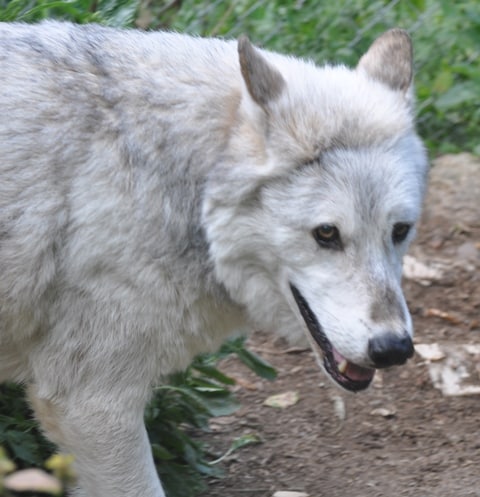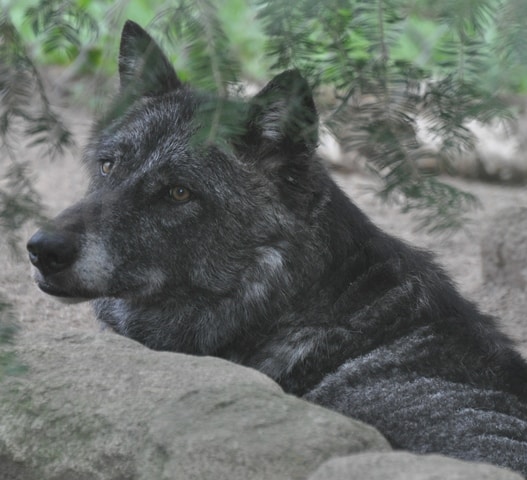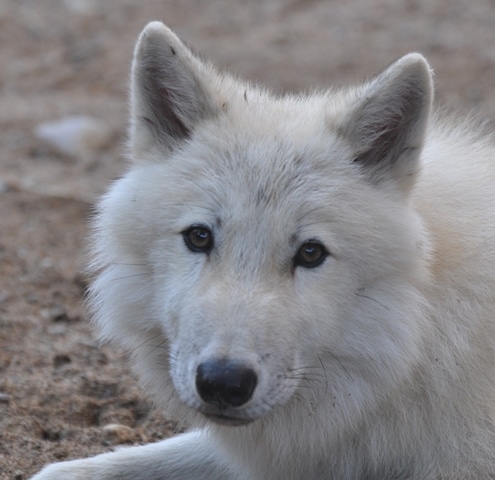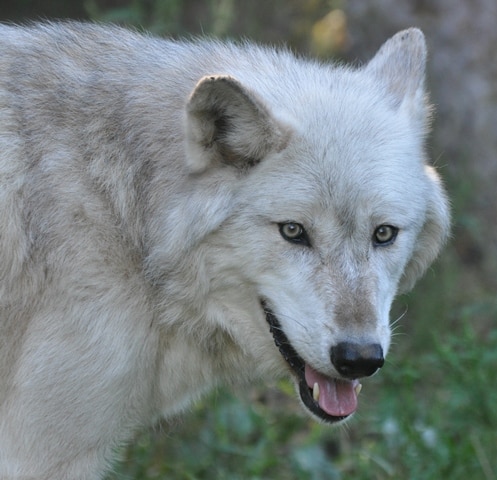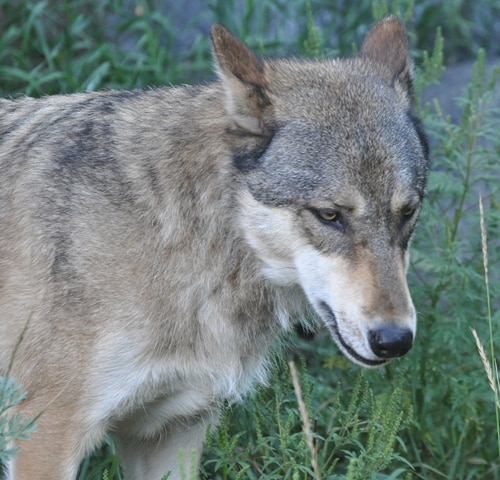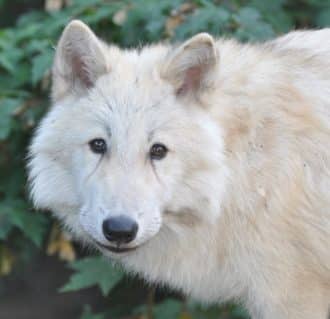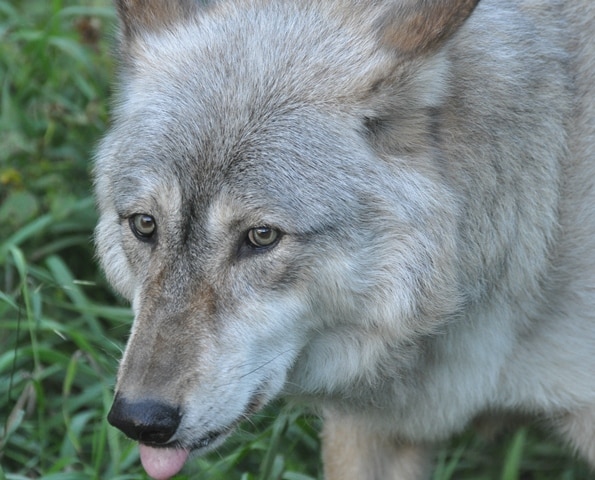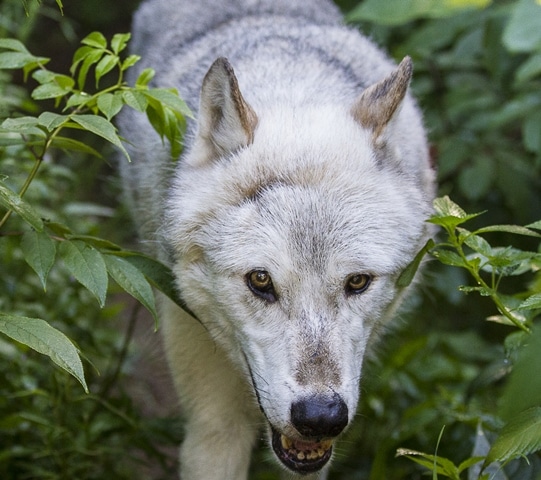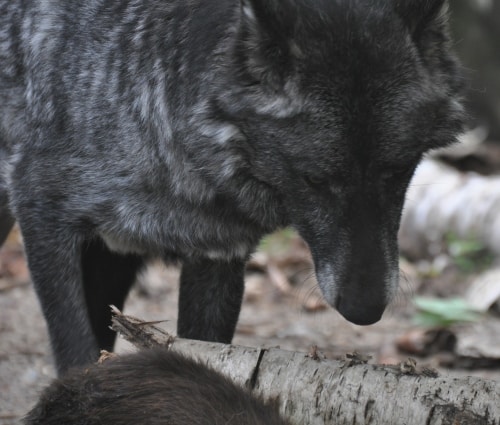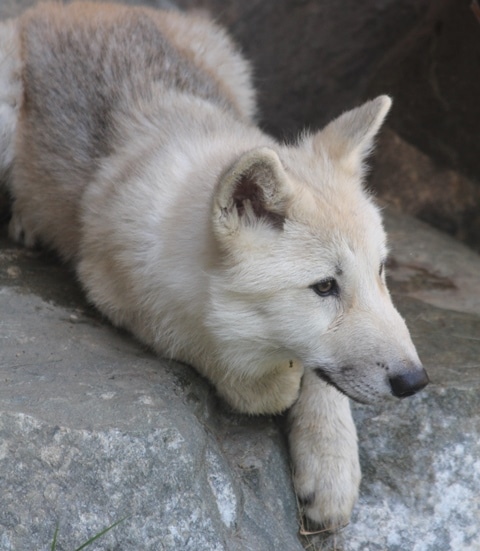While we are managing Luna to have a significant amount of contact and visits, Grizzer’s ear posture reminds us that not every wolf likes a change and stimuli around their enclosure. Grizzer is showing an Ears Pricked and Turned Back ear posture which means he’s alert, but a bit intimidated by the activity around Luna. We always need to be cognitive of each individual wolf’s needs. Grizzer likes interacting with wolf care staff, it just has to be his guest list. We started a new student worker, Justin, from Vermilion Community College to help with facilities, food acquisition and overall wolf care management. Student’s don’t go into the enclosures with adult wolves, but their presence next to the fence requires that the wolves are familiar with them. During Justin’s visits to the Wolf Care Center, Luna will frequently fall asleep next to the fence line, but Grizzer’s a bit more reserved. It will take time before Grizzer opens up to Justin. Calm, quiet visits next to the fence will go a long way to building trust. At 12 years of age, Grizzer deserves his space and comforts and we always want to monitor the impacts of activity around his enclosure.
Archives
I would like to thank everyone who has sent emails about Luna and expressed concern for her current situation. Luna has become quite comfortable with both the indoor Wolf Care Center and outdoor Pack Holding Area. We know that some of her defensive behavior stems from her physical challenges and we are currently in the middle of the physical assessment through x-rays and blood work that will provide details on changes since her last full medical exam in August 2013. In two weeks, all wolf care staff will participate in a two-day training focusing on her anatomy and physiology. This training will include body work that may help Luna’s discomfort and behavioral responses, but will also be an important tool for management of all of our wolves, young and old. Luna is very receptive to wolf care staff interactions and has demonstrated some full extensions of both back legs while submissively resting on her back. This posture presents a great opportunity for staff to do a complete massage to make her as comfortable as possible.
Grayson has displayed more intimidation during the first month of life as an Exhibit Pack member, but he’s definitely gaining confidence each day. We have been very cognitive of opportunities for him to gain confidence, specifically, spending time in the medical enclosure each day. It’s been a slow transformation, but it is rewarding to see this cautious, yet socially engaged pack member develop. Grayson has many behavioral traits similar to Aidan’s few months in the pack as a pup. It’s not surprising that Grayson gets comfort from Aidan interactions. He is slightly behind in Axel in terms of weight gain, but that has been his pattern since he was a pup. He has a good appetite and what may seem like a gap at 4-months of age will likely be narrowed as they approach 6 months of age. We will be offering a Fall is in the Air Webinar on Thursday September 15th that will allow for a live feed from the Exhibit Pack, sharing the behaviors that make this Exhibit Pack blend into a cohesive unit.
The pup introduction started with some challenges and Denali’s overactive interactions have not made it much easier. Denali has been displaying playbow behaviors, which is described as springing up from his front haunches to invite a chase. Needless to say, a 148 pound wolf chasing around the exhibit was a bit intimidating for Grayson. We also witnessed Denali pawing at Axel’s head to invite social interaction, but the size of Denali’s paw gave Axel a bit of a pause. While Aidan maintains the maturity of a pack leader, Denali has reverted to some behaviors reminiscent of his juvenile days.
Boltz continues to show the most submissive behavior toward the pups, often approaching with ears pricked and turned sideways showing interest, but also a calm submissive posture when approaching the pups. In this photo, he shows the characteristic canine grin that usually indicates a bout of chase is about to begin. Initially, Grayson was intimidated by these bouts and Boltz took advantage of Grayson’s weakness by focusing on him, but now, the pups get equal attention from Boltz. Often the pups are found resting with him or there have been times when Boltz has entered the upper wooded portion of the Exhibit, displayed a little whining behavior and was followed down by a pair of pups.
Axel is starting to look like a miniature adult. As we celebrated Axel and Grayson’s 4-month birthday on Friday, September 2nd, his weight is showing rapid growth rate of wolf pups. Axel weighed in at 48 pounds and regularly eats about 2 – 3 pounds of food a day. His main diet is beef or bison, but he likes chicken, liver and bone dust donated by a variety of meat departments. Zup’s grocery in Ely, Minnesota has been saving bonedust for our ambassador wolves since 1989 and we are most grateful. Axel continues to display behaviors that give us and indication that he may have some testing behavior in his future. He frequently postures for food from the adult pack members and usually gets it, even from Denali. But, the behavior most likely to get a swift response from an adult wolf is when he grabs them by the tail. No wolf is immune from this antagonistic behavior, even Aidan.
Adian continues to show strong leadership and associative behavior towards the pups as we are nearing a month since the introduction. Grayson has had some issues with anxiety, but despite his intimidation, he seems to look to Aidan for reassurance. Aidan has a very expressive facial responses when the pups interact, from licking to grinning, he definitely encourages interactions. In a recent YouTube video production, there’s a video clip showing Grayson doing a submissive approach and submissive paw towards Aidan, followed by a clip showing Aidan as a pup displaying the same body posture and same relationship towards Shadow, the pack leader in 2008. Aidan’s come a long way from those timid pup years, maybe Grayson will follow the same path. We recently built the pups a small, birch log area filled with wood chips. We thought it would give the pups a comfortable resting place. Within minutes of completing it, Aidan had claimed it for himself even though the dimensions are more aligned with a pup body.
Wolf care staff are happy to announce that Grizzer has gained back all of his weight from the initial weight loss during last winter, likely due to the constant activity and calorie burn associated with the construction of the Wolf Care Center. Not only did Grizzer benefit from pup leftovers this summer, but staff continue to provide a varied diet and a calm relaxing habitat to keep the calorie consumption high and the burn-off low. At this age, we are happy with his prime weight of 123 pounds. Grizzer is aware of Luna’s new location, but does not show any anxiety or increased activity based on her presence. These two have never met before, as Grizzer was retired before Luna and Boltz were born, but there appears to be no stress from either wolf due to the others presence. I know many have asked if Luna and Grizzer are compatible and at this point, we want to focus on Luna, her physical assessment and if there have been changes to her bone structure. I also need to be mindful of Grizzer’s age and the impact of a younger, more agile packmember can have on a retiree. You may recall Grizzer was in a reverse situation in 2014, when we tried to integrate him with Shadow, but Grizzer’s increased activity and active food defense was a bit too much for Shadow at the age of 14. They were much more compatible sharing a fence-line than having physical interactions. .
Luna’s behavior has been revealing since taking some time out of the Exhibit on the morning of the August 7th pup introduction. We knew the decision we made would have implications, but Luna’s behavior is telling us that a time out from the pack may be what she needed. She is adjusting well to life in the pack holding area and wolf care center and specifically to the additional staff that can now interact with her and the lack of competition during feeding. We recently had a demonstration on “Cold Laser’ technology and its’ benefits to animal care and certainly see some potential for not only Luna, but a variety of wolf management issues. We have scheduled a consultant for a workshop/hand-on training in physical work with Luna for mid-September but again, will also look at work that can be applied to any of the wolves in our care. It’s a special time for wolf care and volunteers to have some quiet time with Luna. It was a rare experience for one-on-one time during her time in the enclosure with greetings often resulting in competition and guarding behavior. We are seeing a new side of Luna that not many people can appreciate. One thing that is important to note, as with any of our ambassador wolves, we assess the physical condition, the individual behavioral displays and the social interactions that help drive management decisions about pack life. This is a practice we have employed for over 25 years; we need to be tuned into the individual and be responsive to changing dynamics that helps guide us in making the best decisions for every ambassador in our care.
This week’s wolf logs are written by behavioral team members Jessica Pierce, Jennifer Ell, and Joyce Turnquist based on their observations during the first week of introduction.
Since introduction day, Grayson has come a long way. This process started with him being very intimidated and having a lot of anxiety due to the drastic change in human interaction. Over the last few days he has sought out humans less and has stated engaging and following the pack. He is still anxious and is very observant before making a decision. However, he has started exploring more on his own and with other members. He still shows signs of intimidation with the adults, specifically Denali, but the progress is evident and increasing every day.

The International Wolf Center uses science-based education to teach and inspire the world about wolves, their ecology, and the wolf-human relationship.

